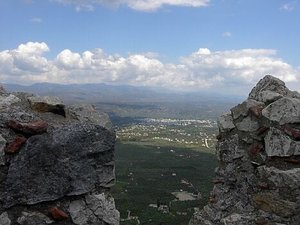Mystras
|
|
For a village in the prefecture of Ioannina, see Ioannina
| Statistics | |
|---|---|
| Prefecture: | Laconia |
| Province: | Province of Lacedaemonia |
| Seat: | Magoula |
| Location: Latitude: Longitude: | 37.506/37°3'59' N lat. 22.06/22°22'35' E long. |
| Population: (1991) - Total - Density¹ - Rank | -4,582 -36.29/kmē</small> |
| Communes: | |
| Elevation: -centre: -highest: | 341 m(centre) Taygetus |
| Postal code: | 231 00 |
| Area/distance code: | 11-30-27310 (030-27140) |
| Municipal code: | 3203 |
| Car designation: | AK
|
| Website: | www..gr (in Greek) |
Mystras (also Mistra, Mystra and Mistras Greek: Μύστρας , Μυζηθράς Mizithras or Myzithras in the chronicle of Morea ) was a fortified town in Morea (the Peloponnesus), on Mt. Taygetos, near ancient Sparta. It lies approximately eight kilometres west of the modern town of Sparti.
Mystras became the seat of the Latin Despotate of Morea, a vassal state of the Latin Principality of Achaea, established in 1205 after the conquest of Constantinople during the Fourth Crusade. Prince William II Villehardouin, a grand-nephew of the Fourth Crusade historian Geoffrey of Villehardouin, built a palace there in 1249.
The Latin despotate was retaken in 1262 by Michael VIII Palaeologus after the recapture of Constantinople in 1261, when John Palaeologus, Michael's brother, ransomed William to the other Latin princes. It remained the capital of the despotate of Morea, ruled by relatives of the Byzantine emperor, although the Venetians still controlled the coast and the islands. Mystras and the rest of Morea became relatively prosperous after 1261, compared to the rest of the empire. Under the despot Theodore it became the second most important city in the empire after Constantinople, and William II's palace became the second residence of the emperors.
Mystras was also the last centre of Byzantine scholarship; the Neoplatonist philosopher George Gemistos Plethon lived there until his death in 1452. He and other scholars based in Mystras influenced the Italian Renaissance, especially after he accompanied the emperor John VIII Palaeologus to Florence in 1439.
The last Byzantine emperor, Constantine XI, was despot at Mystras before he came to the throne. Demetrius, the last despot of Morea, surrendered the city to the Ottoman emperor Mehmed II in 1460. The Venetians occupied it from 1687 to 1715, but otherwise the Ottomans held it until 1832, when it was abandoned by King Otto for the newly rebuilt Sparta.
In 1989 the ruins, including the fortress, palace, churches, and monasteries, were named a UNESCO World Heritage Site.
Nearest places
- Sparta (east)
- Magoula
Communes
- Magoula
- Mystras
Historical population
| Year | Communal population | Change | Municipal population |
|---|---|---|---|
| 1981 | 920 | - | |
| 1991 | 525 | -395/-42.93% | 4,592 |
The municipality seat of Mystras is in Magoula.
The community has a school and a square (plateia).
Byzantine despots of Morea at Mystras
- Michael (1308-1316)
- Andronicus Palaeologus (1316-1322)
- Manuel Cantacuzenus (1348-?)
- Michael Asan ?
- Andrew Asan (?-1354)
- Manuel Cantacuzenus (restored) (1354-1380)
- Matthew Cantacuzenus (1380-1383)
- Demetrius I Cantacuzenus (1383)
- Theodore I Palaeologus (1383-1407)
- Theodore II Palaeologus (1407-1443)
- Constantine Palaeologus (1428-1449)
External links
- Mapquest - Mystras (http://www.mapquest.com/maps/map.adp?tb=1&city=Mystras&country=GR), street map not available
- Coordinates: Template:Coor dms
- traveljournals.net - Mystras (http://www.traveljournals.net/explore/greece/map/m1224724/mystras.htm)
- GTP - Monastery in Mystras (http://www.gtp.gr/LocPage.asp?id=63561)
- GTP - Mystras (http://www.gtp.gr/LocPage.asp?id=9740)
- GTP - Municipality of Mystras (http://www.gtp.gr/LocPage.asp?id=9739)
- Indexmundi - Mystras (http://indexmundi.com/z/?lat=37.9666667=22.7666667&t=p&r=11180&p=mystras&cc=gr&c=greece.htm)
| North: Oinounta | ||
| West: Kalamata in Messenia |
Mystras | East: Sparta |
| South: Farida |

